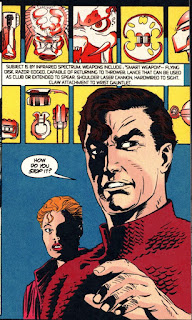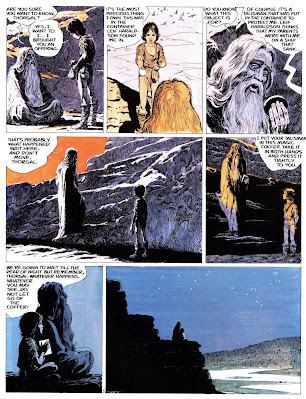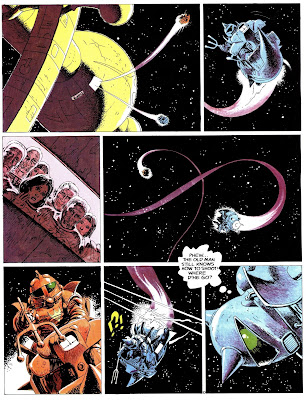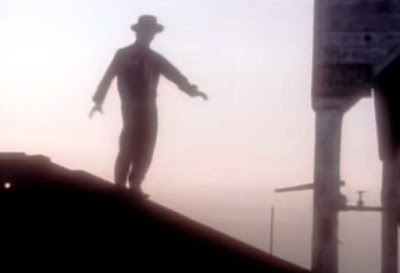Tuesday, November 23, 2021
Book Review: Empire of the East
Saturday, November 20, 2021
Predator Versus Magnus Robot Fighter
Thursday, November 18, 2021
Monday, November 15, 2021
Book Review: Night of the Cooters
1 / 5 Stars
'Night of the Cooters' first was published in hard cover by the small press publisher Ursus Imprints in 1990. This Ace Books paperback version (253 pp.) was issued in July 1993, and features cover art by Don Ivan Punchtaz.This is one of only three novels / anthologies by Waldrop to see print by a major paperback publisher (the other titles being The Texas Israeli War, 1974, and Them Bones, 1984), as the bulk of Waldrop's fiction pieces have been issued by small press publishers.
[ Copies of 'Cooters', being long out of print, have steep asking prices. I was able to get a battered copy for about $10. ]
The stories in 'Night of the Cooters' saw print previously in magazines like Omni, or other anthologies, such as Wild Cards, over the interval from 1977 to 1990.
My capsule summaries of the contents:
Night of the Cooters (1987): Invading Martians discover: you don't mess with Texas.
French Scenes (1988): in the near future, film school students use special software to create mashups contrived from selected segments of classic films. 'Scenes' is designed more to impress the reader with Waldrop's encyclopedic knowledge of film, than to tell an engaging story..........
The Passing of the Western (1989): an alternate-world treatment of How the West Was Won: in this case, through itinerant rainmakers who made the deserts bloom. Waldrop's decision to present the narrative through snippets of faux film magazine / fanzine interviews, including in-jokes about Forry Ackerman (?!) signals that he was trying too hard, to be too clever.
The Adventure of the Grinder's Whistle (1977): a decent Sherlock Holmes pastiche.
Thirty Minutes Over Broadway (1987): this was an entry in George R. R. Martin's Wild Cards shared-world anthology. In New Jersey in 1946, an Airboy derivative, named Jetboy, contends with unscrupulous men who have come into possession of a remarkably lethal alien weapon. It's competent, if unremarkable, proto-Dieselpunk, from a time when the word had yet to be invented.
The Annotated Jetboy (1986): an exhaustive listing, with definitions, of the cultural and technological allusions crammed into almost every paragraph of 'Thirty Minutes'.
Hoover's Men (1988): in an alternate 1929, Herbert Hoover is the head of the federal radio and television authority. A mild example of proto-dieselpunk.
Do Ya, Do Ya, Wanna Dance ? (1988): Frank Bledsoe participates in his 1968 Austin, Texas 20-year high school reunion. This story isn't science fiction, or even speculative fiction. It's a story about someone's high school reunion. I'm not impressed.
Wild, Wild Horses (1988): In Justinian-era Turkey, Renatus Vegetius strikes an unusual deal in order to get his hands on a most treasured book of knowledge.
Fin de Cycle (1990): a novelette comprised of vignettes in which various historical personages interact with one another in 1898 Paris. One of the chapters is titled 'We Grow Bored', and thus says all that can be said about this story...........
The verdict ? There's only one good story in this anthology, and it's 'Night of the Cooters'. All the other tales are duds. I can't recommend this book to anyone other than Waldrop fanatics.
Friday, November 12, 2021
Thorgal: The Talisman
Ink Publishing / The Donning Company, 1986
Wednesday, November 10, 2021
The Last Wolf: Karl Edward Wagner
Monday, November 8, 2021
Young Turks November 1981
He said somehow, some way, it's gotta get better than this
Patti packed her bags, left a note for her mama, she was just seventeen
There were tears in her eyes when she kissed her little sister goodbye
We got but one shot at life, let's take it while we're still not afraid
Because life is so brief and time is a thief when you're undecided
And like a fistful of sand, it can slip right through your hands
Time is on your side
Don't let 'em put you down, don't let 'em push you around
Don't let 'em ever change your point of view
They took a two room apartment that was jumping every night of the week
Happiness was found in each other's arms as expected, yeah
Billy pierced his ears, drove a pickup like a lunatic, ooh
Time is on your side
Don't let 'em put you down, don't let 'em push you around
Don't let 'em ever change your point of view
Woo
Time is on, on your side
He said we're both real sorry that it had to turn out this way
But there ain't no point in talking when there's nobody listening, so we just ran away
Patti gave birth to a ten pound baby boy, yeah
Time is on your side
Young hearts be free tonight
Time is on your side
Young hearts be free tonight
Time in on your side
Time is on, time is on your side
Time, time, time, time is on your side
Is on your side, is on your side
Young heart be free tonight
Tonight, tonight, tonight, tonight, yeah
Ooh, ooh, ooh
Thursday, November 4, 2021
Book Review: Far Away and Never
Tuesday, November 2, 2021
A Trip to Second Story Books Warehouse
A Trip to Second Story Books Warehouse
A couple of weeks ago it was time for my annual pilgrimage to the Second Story Books warehouse in Rockville, Maryland, on 12160 Parklawn Drive.
It was a fine day Autumn day, low 70s and clear blue skies, but the drive in was no fun. I-66 into the DC suburbs is a mess due to the construction associated with widening the highway (it's the biggest civil engineering project in the history of the state). Then a serious accident just before the I-495 exit brought six emergency vehicles creeping past on the shoulder, and stopped traffic on I-66 for 45 minutes. In all, it took me over three hours of trip time to arrive at the warehouse. Luckily they have a restroom available for use by customers..........
I was able to gather a nice collection of vintage paperbacks, all for a couple of bucks each, in a variety of genres:
















































.jpg)























